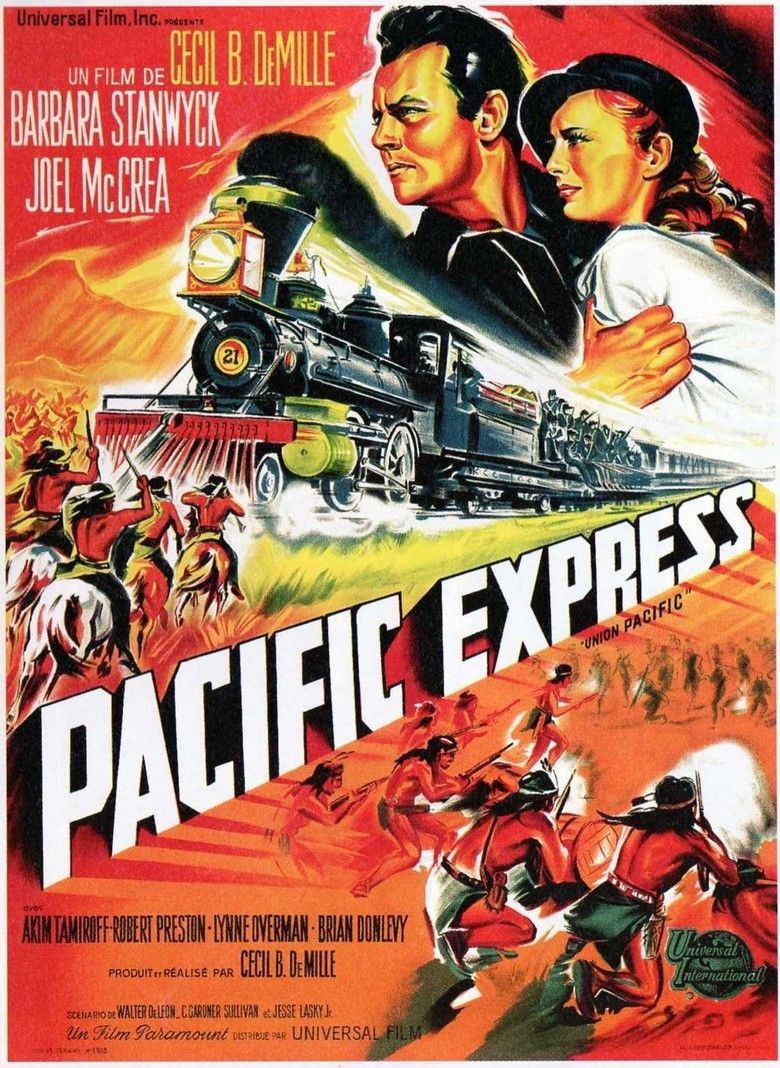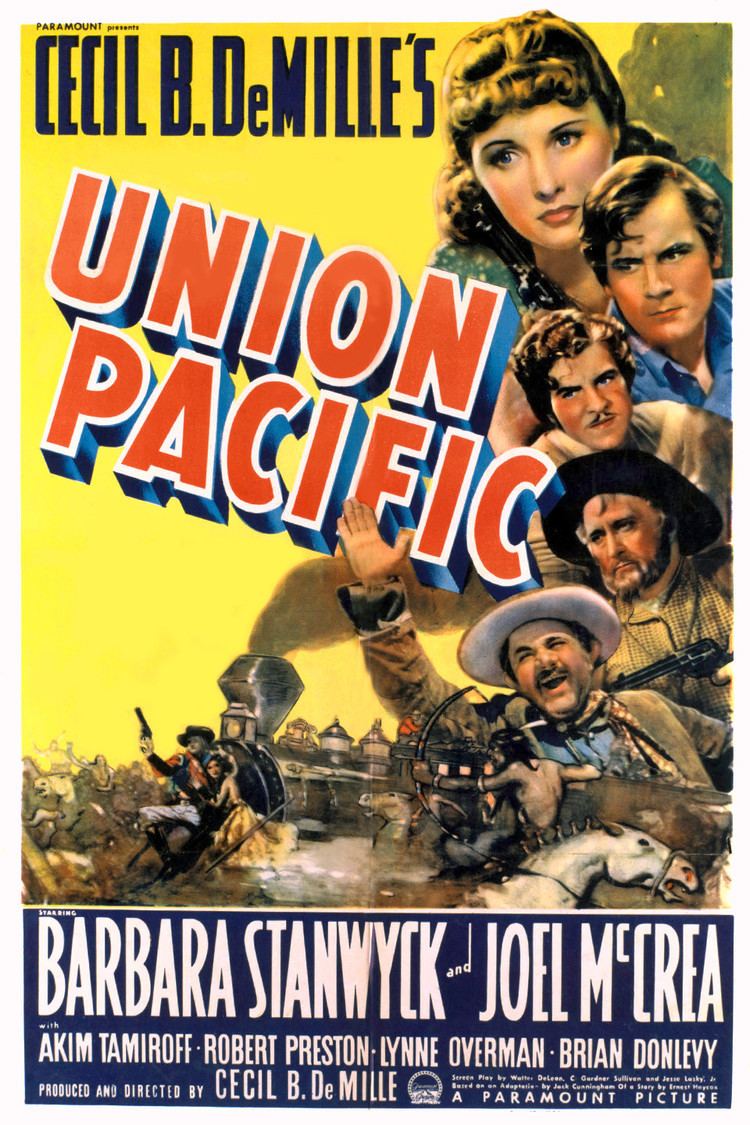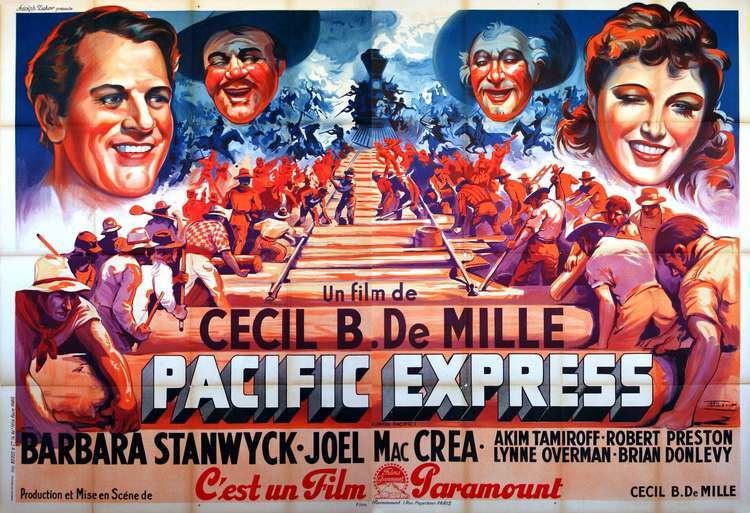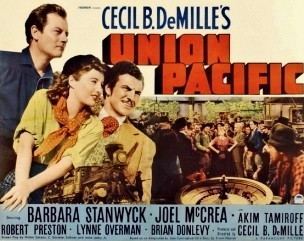Union Pacific (film)
7.2 /10 1 Votes
Music director John Leipold Duration Country United States | 7.2/10 IMDb Language English | |||||||||||||||||||||||||||||||||
 | ||||||||||||||||||||||||||||||||||
Release date May 5, 1939 (1939-05-05) Cast (Mollie Monahan), (Jeff Butler), (Fiesta), (Dick Allen), (Leach Overmile), (Sid Campeau) Similar movies Related Cecil B DeMille movies | ||||||||||||||||||||||||||||||||||
Union Pacific is a 1939 American dramatic western film directed by Cecil B. DeMille, and starring Barbara Stanwyck and Joel McCrea. Based on the novel Trouble Shooter by Western fiction author Ernest Haycox, the film is about the building of the railroad across the American West.
Contents
- Union pacific 1939 main titles
- Plot
- Historical context
- Cast
- Production
- Awards
- World premiere
- Home Video Release
- References

Union pacific 1939 main titles
Plot

The 1862 Pacific Railroad Act signed by President Lincoln authorizes pushing the Union Pacific Railroad westward across the wilderness toward California, but financial opportunist Asa Barrows hopes to profit from obstructing it. Chief troubleshooter Jeff Butler has his hands full fighting Barrows' agent, gambler Sid Campeau. Campeau's partner Dick Allen is Jeff's war buddy and rival suitor for engineer's daughter Molly Monahan. Who will survive the effort to push the railroad through at any cost?
Historical context

Union Pacific was released in 1939 two months after John Ford's Stagecoach, which film historians consider responsible for transforming the Hollywood Western from "a mostly low budget, B film affair." Wheeler M. Dixon, for example, notes that after the appearance of these two films (Union Pacific and Stagecoach), the western was “something worthy of adult attention and serious criticism, and therefore a yardstick against which all westerns have been subsequently measured”.

DeMille's film indeed took the genre to a new level, considering issues of national unity in an engaging and entertaining manner at a time when nationalism was an increasing public concern. Michael Coyne accordingly characterizes Union Pacific as a "technological nation-linking endeavor" in his book The Crowded Prairie: American National Identity In the Hollywood Western. The spirit of unification in the film parallels the industrial boom that brought the United States out of the Great Depression at the onset of World War II, and, although the U.S. would not become involved in the war until 1941, the film’s emphasis on national unity typifies the nationalistic sentiment that would become much stronger once the country was at war.
Cast

Production

According to a news item in The Hollywood Reporter, DeMille directed much of the film from a stretcher, because of an operation he had months earlier. However, studio records indicate DeMille collapsed from the strain of directing three units simultaneously, and used a stretcher for about two weeks.
Parts of the film were shot in Iron Springs, Utah.
The golden spike used at the ceremony to mark the end of the construction was the same spike actually used in the May 10, 1869 event, on loan from Stanford University.
For the Indian attack on the train, Paramount hired 100 Navajo Indian extras.
The company had rented many local Pinto horses for the filming of the Indian attack on the train. During filming, however, local cowboys had to be hired to round up the horses, as they would scatter and sometimes stampede because of the noise and confusion of these scenes—all the shooting, yelling, and yards of unfamiliar cloth on the horses, along with kettles and other implements tied to their manes and tails, made them extremely nervous and uncomfortable, and it didn't require much to make them bolt.
In order to operate the number of trains required by the production, Paramount had to get a regulation railroad operating license from the Interstate Commerce Commission.
Awards
This film is the official winner of the first ever Palme D'Or at the Cannes Film Festival, although this was awarded in retrospect at the 2002 festival. The festival was to debut in 1939, but was cancelled due to World War II. The organizers of the 2002 festival presented part of the original 1939 selection to a professional jury of six members. The films were: Goodbye, Mr. Chips, La piste du nord, Lenin in 1918, The Four Feathers, The Wizard of Oz, Union Pacific and Boefje.
The film was nominated for an Academy Award for Best Special Effects (Farciot Edouart, Gordon Jennings and Loren L. Ryder) at the 12th Academy Awards.
World premiere
The world premiere of the motion picture took place simultaneously at three different theaters (the Omaha, Orpheum, and Paramount) in Omaha, Nebraska, on April 28, 1939, just three weeks shy of the 70th anniversary of the driving of the real Golden Spike which joined the rails of the Union Pacific and the Central Pacific Railroads at Promontory Summit, UT, on May 10, 1869. The premiere was the center piece of a four-day (April 26–29) combined event called the Golden Spike Days Celebration and Golden Spike Historical Exposition that drew 250,000 people to the city thereby temporarily doubling its population and requiring the National Guard to help keep order.
A special train transported DeMille, Stanwyck, and McCrea from Hollywood to Omaha. The trip took three days and made stops along the way, drawing large crowds. President Franklin Delano Roosevelt inaugurated the overall celebration by pressing a telegraph key at the White House in Washington, DC, which opened the civic auditorium. An ad stated that the premiere, which involved parades, radio broadcasts and a banquet, was the biggest in motion picture history. An antique train continued on a 15-day coast-to-coast promotional tour, stopping at 30 cities around the country.
Home Video Release
This film, along with The Sign of the Cross, Four Frightened People, Cleopatra and The Crusades, was released on DVD in 2006 by Universal Studios as part of The Cecil B. DeMille Collection. The film received a standalone DVD release in 2014 as part of Universal's "Vault Series" line. Neither release has a chapter selection or any additional features.
References
Union Pacific (film) WikipediaUnion Pacific (film) IMDb Union Pacific (film) themoviedb.org
